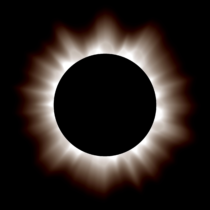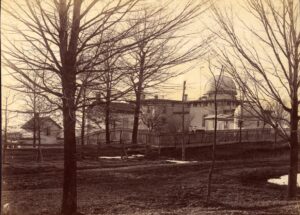Magazine

Total Eclipse of the Sun
By Robert Havey
James Craig Watson was an astronomical genius, becoming the second director of the Detroit Observatory at the young age of 25. In the summer of 1878, he headed west to observe a solar eclipse, confident he would find a new planet. The story of his quest—preserved in his papers at the Bentley—reveals the challenges of science in the late-1800s and the fine line separating fascination and folly.
Professor James Craig Watson was already an internationally famous astronomer on July 20, 1878, when he left Ann Arbor to embark on the most important scientific expedition of his life.
Watson was renowned, by both his peers and the general public, for his uncanny talent for discovering “minor planets,” now more commonly called asteroids. He had found 22 new asteroids, including six in a single year. But when Watson boarded a westward-bound train in the summer of 1878, his goal wasn’t to find another asteroid. Watson was hunting bigger game.
He was looking for the planet Vulcan.
Vulcan was thought to exist beyond Mercury in a close orbit to the sun, so close that the sun’s light would overwhelm any light reflected from Vulcan’s surface, making it impossible to detect under normal circumstances. The only way for Watson to observe Vulcan was to find it in the sky during the scant few minutes of a total solar eclipse.

Professor James Craig Watson in an undated photo, HS4175.
Watson arrived in Rawlins, Wyoming, after a two-day train ride. Rawlins was a town founded solely because of the Union Pacific Railroad, a frontier town with nothing but windswept prairie beyond its city limits. The path of an eclipse was going to cut through the western United States on July 27, 1878. The eclipse would reach Rawlins at 3:13 p.m. History would not wait.
Tedious Observation
Astronomers in the 1800s didn’t have satellites, digital imaging, or computer models to find Earth’s close celestial neighbors. They didn’t even have electric lights.
To be a planet hunter in the 1800s involved sitting at a telescope for hours at a time in complete darkness, scanning a tiny section of the night sky for motes of light, all while precisely recording everything in a journal including the exact time and position of the telescope.
The next step was to take the observations and compare them to a star chart, a grid map of all the known objects in a particular section of space. If a planet hunter found a speck in the sky that wasn’t recorded on the star chart, they would write letters announcing that a new object was found. Other astronomers might respond with confirmation, having seen the new object in their own telescopes, or, in the worst case, respond that it had already been spotted weeks earlier by someone else.
It was this practice of tedious observation and record keeping at which Watson excelled. He was 25 when he discovered his first asteroid, which he named Eurynome. Even at that young age, Watson was already a professor of physics and math at the University of Michigan, and had just succeeded his mentor, Franz Brünnow as the director of the Detroit Observatory.
“Watson was a child prodigy and clearly a genius in many fields, including astronomy and mathematics,” said Director of the Detroit Observatory Gary Krenz in an interview. “He was able to do complex calculations like an asteroid’s orbital trajectory in a few hours rather than the days it would take other astronomers.”
Watson might have also been a victim of his own ambition and early success. “One of the criticisms leveled by his peers was that Watson’s work was great but not deep,” said Krenz. “For example, the textbook he wrote was used for many years, but compared to the one written by Brünnow, it lacked scientific rigor.”
It’s also possible that his ambitions made Watson a less-than-diligent instructor. He once gave every student in his class a passing grade on the final, including a student who had died early in the semester.
But at night in the isolated Detroit Observatory, in the complete darkness, Watson was able to shine bright.
Planet at the Point of the Pen
In 1846, the French astronomer Urbain Le Verrier did something astounding: he discovered a planet not with a telescope, but with math.
Le Verrier figured out that the only way to account for the uncanny orbit of Uranus, which defied Isaac Newton’s law of universal gravitation, was for there to be another undiscovered planet acting on it. Le Verrier worked out by hand the grueling equations and sent a prediction of where this planet would be to Johann Gottfried Galle at the Berlin Observatory. Within less than a degree away from Le Verrier’s prediction, Galle found an object not on any star chart. They had discovered Neptune.
Not content with one solved celestial mystery, Le Verrier turned his attention to Mercury. Mercury also perplexed astronomers with its orbit, which, like Uranus, defied Newton’s equations. Again, Le Verrier predicted a theoretical planet, this time in between Mercury and the sun. He named his planet “Vulcan” after the Roman god of fire and again waited for confirmation.
Separation Anxiety
The Railroad Hotel in Rawlins, Wyoming, was full to bursting with scientists and press. The town had been hastily constructed just a decade before to accommodate the Union Pacific trains that rolled through at a constant clip.
Watson was one of the late arrivals. He only brought two things with him: his wife, Annette, and the “Comet Hunter” telescope he had borrowed from Michigan State Normal School (now Eastern Michigan University). The Comet Hunter was a newer and bigger telescope with better optics than U-M’s Comet Seeker.

James Watson (sixth from right) joins scientists including Thomas Edison (second from right) in Wyoming in 1878 to observe a solar eclipse in hopes of confirming the existence of the planet Vulcan. Image courtesy of the Carbon County Museum.
Watson wasn’t the only celebrity among the dust and tumbleweeds. Thomas Edison had come to test his new invention, the tasimeter, a device he claimed could measure temperature from distant objects. (The device only partially worked and Edison, who held more than 100 patents at this time, didn’t bother to file one for the tasimeter.)
All of this attention on the eclipse provided an opportunity for American scientists to prove to their European colleagues that they could conduct important research. Total solar eclipses are rare events and often don’t appear in places ideal for viewing. With the eclipse passing through the heart of the western United States, the pressure was on to produce results.
“Post-Civil War American science was small but emerging, and astronomy was a big part of that,” says Krenz. “At the time, only a handful of American scientists could be considered world-class, but Watson was among them.”
The time leading up to the eclipse did not go as smoothly as Watson would have liked. The telescope he brought lacked setting circles, or circular dials crucial for calibration. Astronomers need to know two coordinates—declination and right ascension—so they can know precisely where they are looking in the sky. Without the circles, there would be no way to be certain that any object Watson saw wasn’t just a previously discovered star. Watson had to commission a local carpenter to cut two wooden circles to use as makeshift parts.
The day of the eclipse came with a nearly cloudless sky. For reasons unknown, Watson suddenly decided that Rawlins was an unacceptable location to view the event. Watson and Annette packed the equipment, left Edison and the others, and moved down the rail line a few miles to a tiny train depot named Separation. Watson and Annette lugged their equipment almost a mile through thorny brush to join another small group of scientists who were busily preparing.
Somehow Watson was able to set up everything in time. At 2:34:16.4 p.m., an undulating darkness crept over the land from the north. Watson couldn’t let himself get caught up in the eerie beauty. Every second of the eclipse was precious. As the shadow passed over the assembled scientists, Watson got to work.
Captain William H. Bisbee of the U.S. Naval Observatory was in charge of marking time for the group, calling out every 10 seconds. Watson began methodically scanning the sky, starting with the sun and looking out in a precise pattern. Nothing for the first minute 30 seconds. The eclipse was half over.
Then, finally, something came into focus. Watson saw a reddish object. It didn’t look like a star and didn’t have the tell-tale tail of a comet. He carefully marked the position of his telescope on his makeshift wooden circles.
In the final minute of the eclipse, Watson found another object he could not identify. With just seconds left he didn’t have time to check its position against other stars, but was able to mark it down.
The blazing July sun reappeared. Watson was able to relax. He had done it. He found not one, but two Vulcans.
Down a Well
Watson was hailed as a hero across the country. America had discovered a planet of its own. “PROFESOR WATSON FINDS VULCAN” was the headline in the Laramie Daily Sentinel, one of the first of many papers exhorting Watson’s find.
But as the massive work of compiling the observations of researchers and amateurs began, doubt crept in. No one among the hundreds of eclipse watchers had seen either of Watson’s Vulcans. An amateur astronomer, Lewis Swift, stepped forward to say he had also seen the two objects, but later had to rescind his report when he discovered an error in his calculations.
The controversy put Watson’s crowning achievement in doubt.
C. H. F. Peters, Watson’s planet-hunting rival, published a scathing critique in the leading astronomy journal Astronomische Nachrichten.

The Detroit Observatory, 1888, HS909.
Despite the controversy, Watson was able to leverage his notoriety into a job offer from University of Wisconsin. U-M said publicly that they tried to retain their star astronomer, but Krenz thinks it’s possible they didn’t try hard enough.
“The great innovation in astronomy at that time was photography and spectroscopy, and the Detroit Observatory just wasn’t set up to do those things,” says Krenz. “We have records of Watson requesting funds from the Regents for a spectrometer, but he was denied. He got to build a brand new observatory at Wisconsin.”
Watson arrived on the University of Wisconsin’s campus filled with ideas. He wanted to dedicate the next phase of his career to confirming his observation of Vulcan. He even designed an observatory addition with a telescope deep below ground level, looking up at the sky through a hole. The idea—a very wrong idea, as it happens—was that the light from the sun wouldn’t reach the telescope in the hole and therefore daytime observations would become possible.
Everything is Relative
So what of Vulcan? Other astronomers continued the search for it or any other inter-Mercurial planets during the eclipses of the next half-century, but with no success. The orbit of Mercury remained a mystery.
It’s unclear exactly where Watson went wrong. It’s possible that between the wooden setting circles, the rush of the last-minute location change, and/or the narrow observation window, Watson saw a known object but had the coordinates wrong.
The solution finally came once again via a pen rather than telescope. This time the pen was wielded by Albert Einstein. Einstein’s theory of general relativity refined Newton’s laws and provided an explanation for Mercury’s strange orbit.
Einstein’s theory was dramatically confirmed by two groups of astronomers measuring the bend of light around the sun during a total solar eclipse in May 1919.
